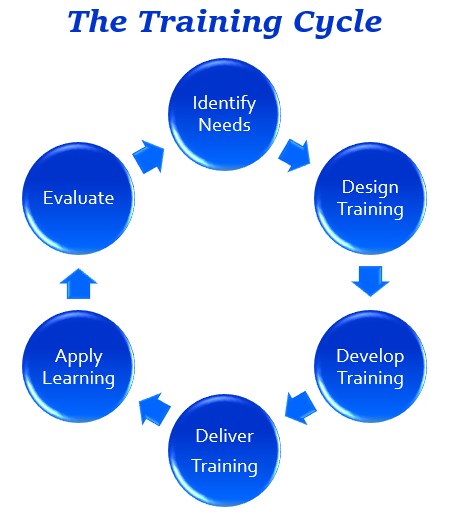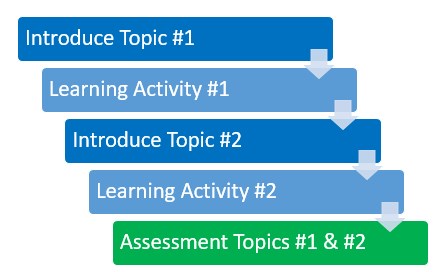The Training Cycle
The Training Cycle is a systematic approach to the development, delivery, and continuous improvement of a training program. It consists of an orderly series of stages to help ensure that the training results in what is desired and intended.
About the Training Cycle
The Training Cycle begins long before the training program is conducted and continues long after the program has been completed. In the training cycle, the emphasis is not simply on a training event itself, but also on the planning, development, and review stages.
The Training Cycle has six stages:
- Identify Training Needs
- Design Training
- Develop Training
- Deliver Training
- Apply Learning
- Evaluate Program

Training Cycle Overview
The Training Cycle starts with the identification and assessment of the training needs. This stage helps determine whether training is even needed and if so what needs to be trained. If this step is missed, you may be creating an expensive and time consuming training program when the issue could be resolved by something as simple as providing a job aid to the staff.
Once the need for training has been established and the training requirements identified, an effective method of training can be designed. This stage includes determining the best method of delivery which may include instructor-led, online, self-study, or a blended method.
After the training has been designed, the materials including job aides, activities, PowerPoints, and assessments can be developed, and the training can be delivered.
After the training is delivered, the individuals will need time apply what they have learned. This stage occurs when the individual is on the job working in a live environment. They may be working independently or under the guidance of a peer, but either way they will be applying what they learned in training as they perform their job tasks.
After the individuals have had a chance to apply the learning, the effectiveness of the training should be assessed and those findings integrated into an overall evaluation and review process to allow improvements to the training program.
Stage 1: Identifying Training Needs
The first stage in the training cycle is to identify and assess any training needs. This stage is extremely important because if you do not address the right issues, or if you do not identify actual training needs, then the training will not achieve what you want it to. Delivering training that does not have a clearly identified needs and objectives will not meet the needs of the individuals or the organization.
After you have determined that there is a legitimate training need, the next step is to state exactly what you want the training to accomplish. You do this by writing learning objectives that specify what the learner should be able to do after the learning event.
Stage 2: Design
After you have identified the training needs and determined the objectives, you can begin the program design. The first step in the design phase is to determine what type of training is the best option to achieve the learning objectives.
Possible options include;
- Instructor-led classroom training
- virtual training
- self-paced e-learning
- self-study
- on the job
- combination of these and others in a blended learning solution
The next step in the design stage is to structure the training to create a framework for the delivery of the training content. Basically, you structure what you want to address at the beginning, middle and end of the training course. This will include determining when and what information is presented, when to conduct learning activities, and when to have assessments. The entire course design should be systematic and logical with each segment linked to and building on the previous.

Stage 3: Develop the Training
After the course is designed and the framework is set, both reference material and learning activities are created for the participants in order for them to understand and practice the new knowledge or skills.
Creation and assembly of the materials that may be utilized in the training course include:
- instructor’s guide
- participant’s guide
- reference guides
- job aids
- handouts
- presentations
- assessments
Learning activities are experiences that allow the learner to practice applying the new skills and knowledge. The activities should prepare the learner for the assessments which test their knowledge of the topic. These activities can be done as a large group, small group, or as individual assignments.
Activities include:
- written workshops
- group discussions
- role plays
- simulations
- games
Stage 4: Training Delivery
The delivery stage is when the learners attend the training session or take the training course (online or self-study). An effective training program allows the attendees to actively participate in the learning process and to practice their new skills and knowledge. Learning is enhanced when the learners have time to reflect upon the training, so it is important to allow time for reflection during the course.
Stage 5: Apply Learning
After the training event, the learners need to be given the time and opportunities to put their learning into practice. This stage is necessary if any real change is to occur following the training event. This stage should be conducted shortly after the training event, because new learning is most effective if applied while the new information in fresh in the learner’s mind.
Ideally, peers or supervisors will be there to support the learner through the process of applying what they learned to their job functions and tasks. Feedback from these individuals will help the learner effectively apply their learning.
Stage 6: Evaluate the Training Program
The final stage in the Training Cycle before you begin the needs analysis stage again, is the evaluation stage. This stage is essential because if you do not evaluate the impact of training, you will not know whether the training is having the necessary impact and effectiveness. Without an evaluation process training quality cannot be assured and appropriate improvements cannot be made to maintain standards.
Training evaluations are conducted with the intent of obtaining information on the effectiveness of the training program. The most common way to evaluate training is to get the learners to complete a form at the end of the training event where they give feedback on whether they thought it was useful, and what they thought of the trainer. This information can be helpful, but it does not measure what was actually learned by the attendees (only what the attendees thought they learned).
Training evaluations are conducted to ensure the training and content achieved the learning objectives. At the conclusion of the session, the attendee may think they can apply the information they learned to their job functions, but that cannot be verified until they actually attempt to implement their learning on the job. That is why it is necessary to conduct an evaluation after the learner has had time to implement it. This may be weeks after the actual learning event.
